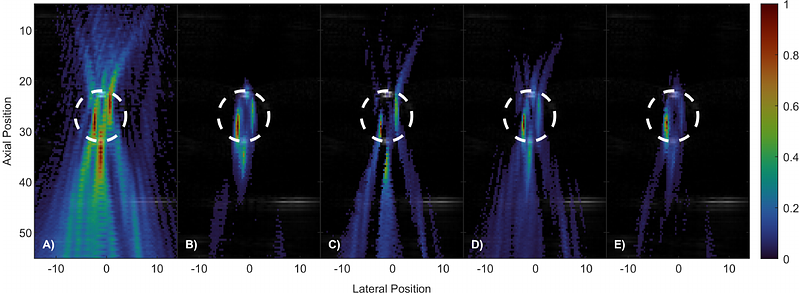Passive Acoustic Dynamic Differentiation and Mapping: A Time-Domain Passive Cavitation Localization and Classification Approach

Passive Acoustic Dynamic Differentiation and Mapping: A Time-Domain Passive Cavitation Localization and Classification Approach
Caso, N.; Patel, K. S.; Sun, T.
AbstractObjective: Passive cavitation imaging and control has explored various beamforming algorithms to balance resolution, imaging artifacts, and computational speed. Optimizing these parameters is essential for clinical translation, as precise cavitation localization and dosage control are critical for Focused Ultrasound (FUS)-based targeted therapies, minimizing unintended tissue damage. Among commonly used methods, Delay-Sum-Integrate (DSI) and Robust Capon Beamforming (RCB) have demonstrated effectiveness but are limited by either significant artifacts or the need for extensive parameter tuning. Methods: This work introduces Passive Acoustic Dynamic Differentiation and Mapping (PADAM), which adapts the Multiple Signal Classification algorithm to the time domain to improve cavitation localization. Results: PADAM achieves up to a 6-fold improvement in lateral beam-width compared to RCB, and a 4-fold reduction in mean-square intensity of artifacts. It further unveils a novel physical insight: its input parameter dynamically gauges the richness of an incoming signal\'s frequency content. This feature enables a more physically defined and intuitive parameter for distinguishing between stable and inertial cavitation based on spectral characteristics, simplifying parameter selection and enhancing the framework for cavitation monitoring and control. Conclusion: With its ability to improve resolution, reduce artifacts, and provide computational efficiency, PADAM represents a promising advancement for precise cavitation localization and therapy monitoring. Significance: This work introduces PADAM, a novel time-domain passive cavitation imaging method that offers superior resolution and artifact reduction compared to DSI and RCB. Its physically intuitive input parameter enables dynamic differentiation between stable and inertial cavitation, enhancing precision in the monitoring and control of FUS therapy.